SLVA954B October 2021 – August 2022 ESD751-Q1 , TPD1E01B04-Q1 , TPD1E05U06-Q1 , TPD1E10B06-Q1 , TPD1E10B09-Q1 , TPD2E001-Q1 , TPD2E2U06-Q1 , TPD4E001-Q1 , TPD4E02B04-Q1 , TSD05C
2 ISO 10605 ESD Waveforms and Test Parameters
Texas Instruments (TI) uses industry standard ESD test generators calibrated to the ISO 10605 test waveforms to conduct testing. ISO 10605 is partly based on IEC 61000-4-2, a standard that covers system level ESD immunity; however, it has several key differences specific to automotive applications. Unlike IEC 61000-4-2, ISO 10605 does not define specific upper limit of stress voltage. However, the test voltages are generally in the range of 2 kV to 15 kV for direct contact discharge, and 15 kV to 25 kV for air gap. Some automotive manufacturers have their own specifications, and some parts can have specifications as high as 30-kV contact, 30-kV air gap discharge. The generator is set to meet the parameters shown in Table 2-1.
| Parameter | Characteristic |
|---|---|
| Output voltage (contact discharge) | 2 kV to 15 kV (or as defined by test plan) |
| Output voltage (air gap discharge) | 2 kV to 25 kV (or as defined by test plan) |
| Output voltage accuracy | ≤ 5% |
| Output polarity | Positive and negative |
| Rise time of short circuit current in contact discharge mode (10% to 90%) | 0.7 ns to 1.0 ns |
| Interval time | Minimum 1 s |
| Holding time | ≥ 5 s |
| Capacitances | 150 pF or 330 pF |
| Discharge resistances | 330 Ω or 2000 Ω |
ISO 10605 testing uses two different resistors, 2000 Ω and 330 Ω, to simulate different types of ESD events. The 2-kΩ resistor represents a human body discharging directly through the skin, while the 330-Ω resistor simulates a human body discharging through a metallic object. The test is also done at two different capacitances: 150 pF and 330 pF. These values represent a human body outside and inside the vehicle respectively. The 330-pF and 330-Ω test is the highest energy or current of any of the ISO 10605 test parameters, and thus is the most widely used test standard.
Figure 2-1 is an example of the ISO 10605 Discharge Equivalent Circuit.
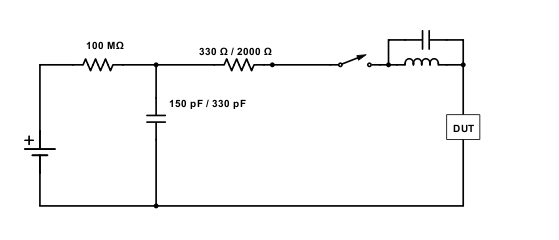 Figure 2-1 ISO 10605 Equivalent
Circuit
Figure 2-1 ISO 10605 Equivalent
CircuitThe circuit starts off with the switch open, and charges the 150-pF, 330-pF capacitor. Then the discharge is represented by the closing of the switch, which causes the capacitor to discharge across the DUT. The resistor represents the resistance of the gun, and the inductor and capacitor represent the L-C parasitics.
Table 2-2 summarizes the similarities and differences between ISO 10605 and IEC 61000-4-2 test parameters. The 150-pF and 330-Ω test is roughly equivalent to the IEC 61000-4-2 test.
| Standards | ISO 10605 | IEC 61000-4-2 | ||
|---|---|---|---|---|
| Parameter | Contact | Air Gap | Contact | Air Gap |
| Output voltage | 2-15 kV | 2-25 kV | 2-8 kV | 2-15 kV |
| Interval time | Minimum 1 s | Minimum 1 s | ||
| Network capacitance | 150 pF, 330 pF | 150 pF | ||
| Network resistance | 330 Ω, 2000 Ω | 330 Ω | ||
| Number of discharge pulses | Minimum 3 | Minimum 10 | ||
| ESD generator ground reference | Battery Ground | Earth | ||
| Test conditions | Unpowererd, Powered with Battery | Powered | ||
Figure 2-2 and Figure 2-3 show the different waveforms at their respective capacitance and resistance levels. Figure 2-2 through Figure 2-5 are example waveforms of 5-kV contact discharges, and help illustrate the variation in energy dissipation related to the resistance and capacitance values. Figure 2-4 and Figure 2-5 show the waveforms of 5-kV contact discharges under ideal conditions. The noise seen in Figure 2-2 and Figure 2-3 could be attributed to a variety of factors, such as L-C parasitics or noise from the generator or discharge gun.
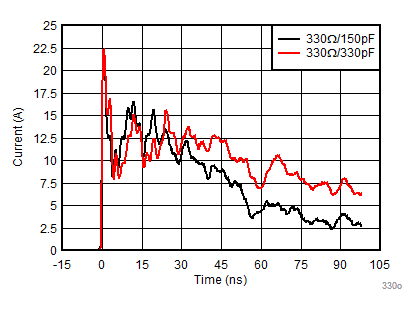 Figure 2-2 330-Ω, 5-kV Contact
Discharge
Figure 2-2 330-Ω, 5-kV Contact
Discharge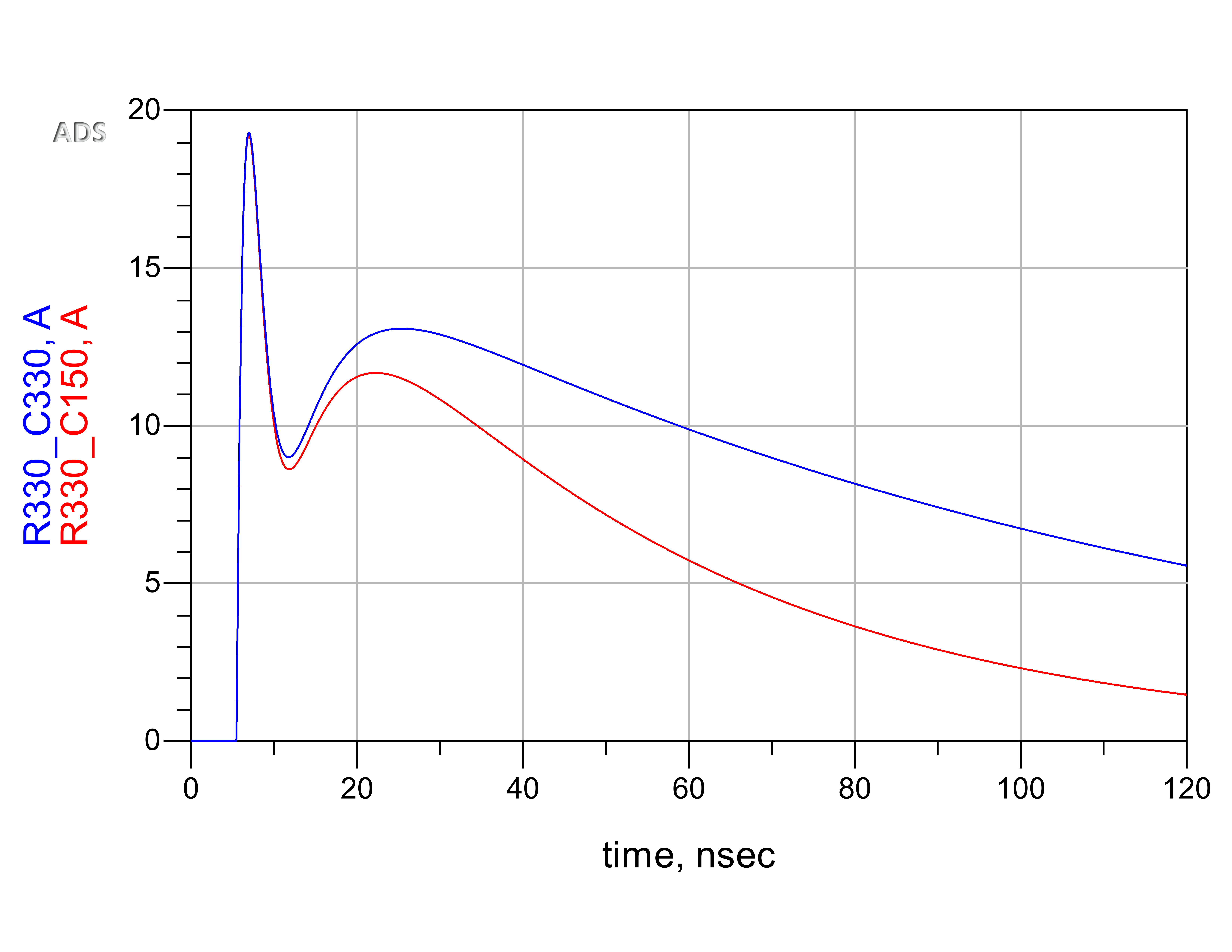 Figure 2-4 330-Ω, 5-kV Contact
Discharge Ideal Current Waveform
Figure 2-4 330-Ω, 5-kV Contact
Discharge Ideal Current Waveform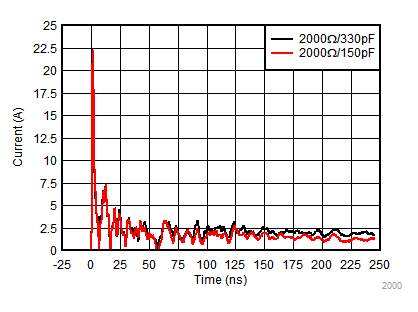 Figure 2-3 2000-Ω, 5-kV Contact
Discharge
Figure 2-3 2000-Ω, 5-kV Contact
Discharge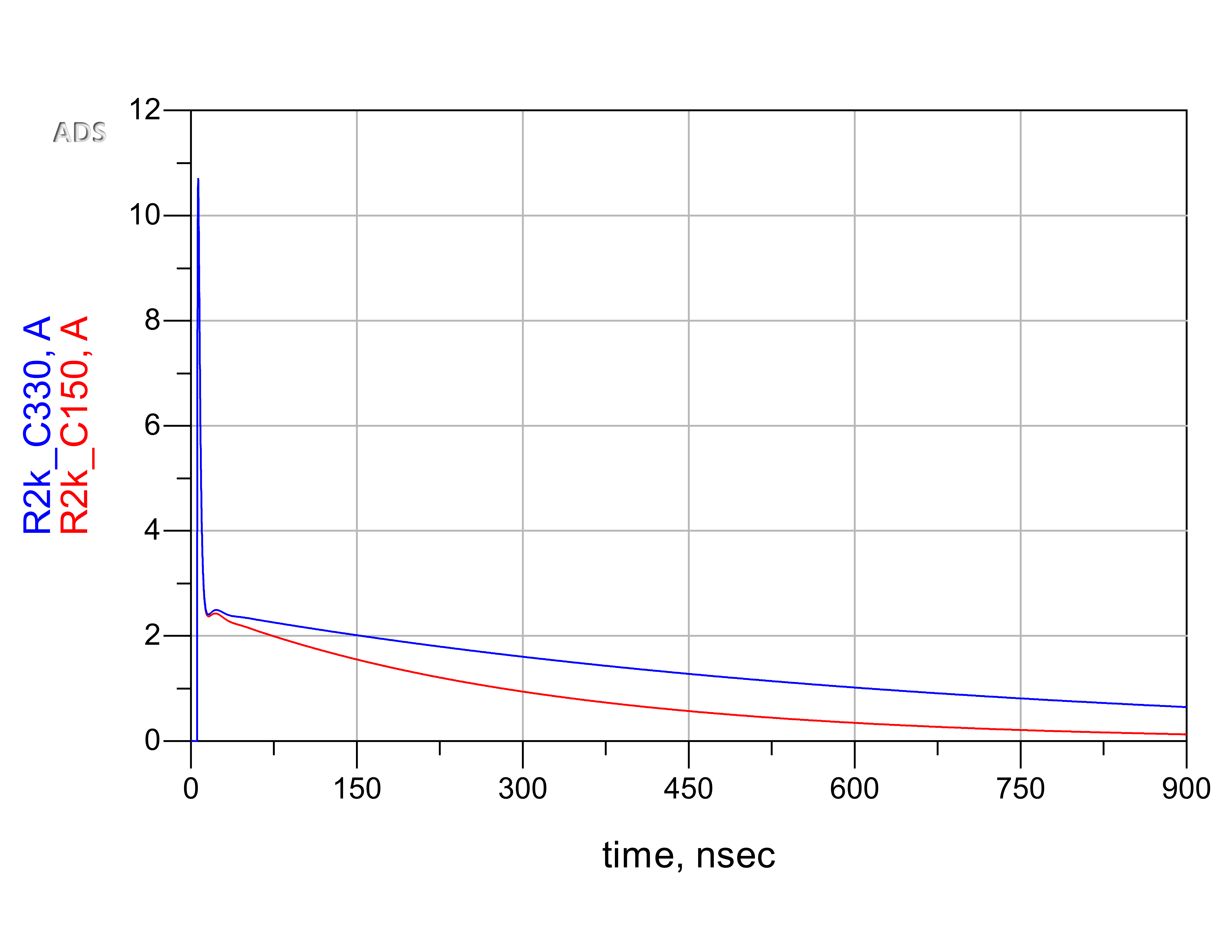 Figure 2-5 2000-Ω, 5-kV Contact
Discharge Ideal Current Waveform
Figure 2-5 2000-Ω, 5-kV Contact
Discharge Ideal Current WaveformAs illustrated in Figure 2-2 through Figure 2-5, the 330-pF discharge (simulating a body inside the vehicle) has more energy than the 150-pF discharge (simulating a body outside the vehicle). This is because the higher capacitance dissipates over a longer period of time. The 330-Ω discharge also dissipates more energy than the 2000-Ω discharge due to its lower resistance. Because of this, the 330-Ω and 330-pF discharge has the highest energy of any of the tests, which is shown by having the largest area under its curve below.
Since IEC 61000-4-2 has a lower capacitance of 150 pF and 330 Ω, ISO 10605 at 330 pF and 330 Ω has a longer period of energy dissipation. Because of this, the stress on the device and change in temperature in ISO 10605 is significantly higher than IEC 61000-4-2, making it a more intensive test.